There are exceptions to almost every rule in 2022 – and, as ever, it’s essential to asses wines individually. Here, however, we break down the region by commune to offer an overview of how each subregion fared in this fascinating vintage
THE LEFT BANK
The gravel soils of the Left Bank are beautifully free-draining – something that has long been key to the fine wines despite the wet, maritime climate of the Médoc. In 2022, however, producers were desperate to retain what little water fell from the skies – and the berries harvested were tiny, with thick skins and containing surprisingly little juice. The size of the grapes, combined with localised hail in Saint-Estèphe, resulted in generally low yields in 2022 – often lower than 2021, although it does vary by estate. Any addresses working organically and biodynamically last year had catastrophic yields, and this year therefore seemed generous (and joyous) for them, with its dry conditions meaning minimal disease pressure. What little fruit was harvested, however, was ripe and concentrated – producing rich and structured wines, with the best also having amazing freshness.
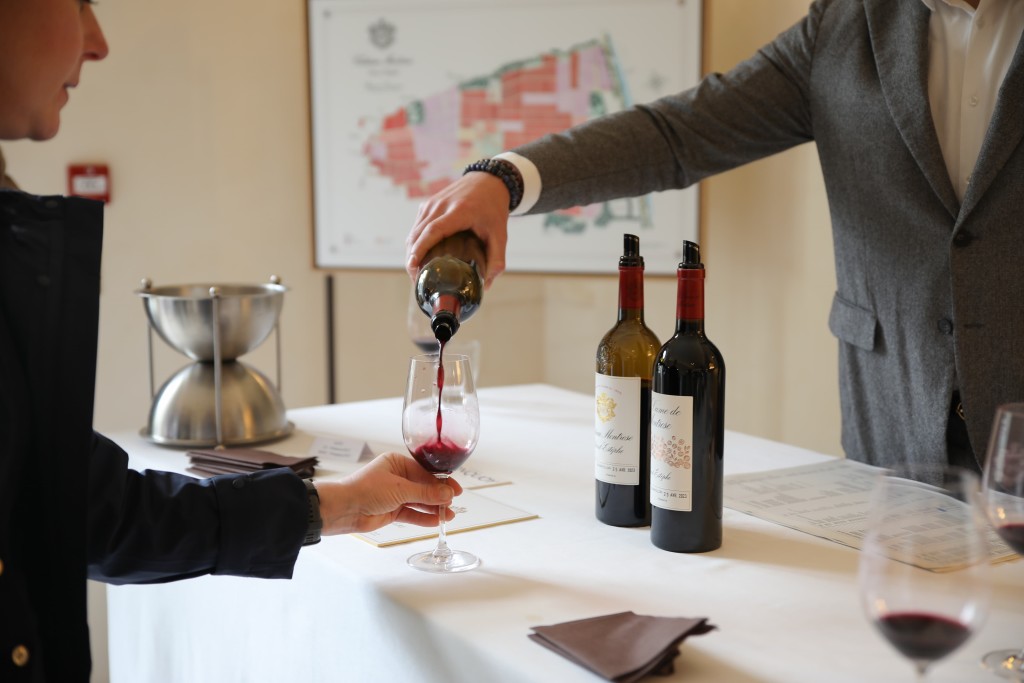
Tasting at Ch. Montrose, which has produced a pair of beautiful wines in 2022
Saint-Estèphe
This northern commune tends to thrive in hot vintages, with the heavier, clay-rich soils retaining more water and cooler temperatures, limiting the vines’ stress – and it was just so in 2022, a vintage in which it seems to be one of the more consistent appellations. Unfortunately the northern reaches of the region were struck by a corridor of hail on 20th June – it was very localised, but some estates lost significant volumes (with reports of up to 80%). At Ch. Beau-Site, the combined effects of this hail and April frost led to a loss of around half their crop, while Phélan-Ségur lost 30%.
Picking dates here varied – with Montrose (that has produced one of the stars of the year) starting on 2nd September, Calon Ségur on 6th and Cos d’Estournel on 7th – the earliest harvest for the latter since 1989. Even without any hail damage, Cos only managed to crop 33hl/ha, compared to a normal 40hl/ha. It’s also the first release of Cos Labory under Michel Reybier – reuniting the land that was originally owned by Louis Gaspard d’Estournel – and many more changes are set to come here. As they just acquired the estate, they were only responsible for the blending and élevage – but it’s already showing a touch of the classic Cos polish.
At Montrose, they felt there was a need to “civilise” the tannins, with gentle extraction. At Calon Ségur, Vincent Millet chose a longer, cooler fermentation at 24˚C ; for him, it’s the low yields that give the vintage such power, while the freshness remains a mystery. The wines that we tasted showed none of the rusticity that was once the trademark of Saint-Estèphe, with the best combining a depth of dark fruit and charming freshness.
Our highlights: Montrose – and especially La Dame de Montrose, Calon Ségur, Phélan-Ségur
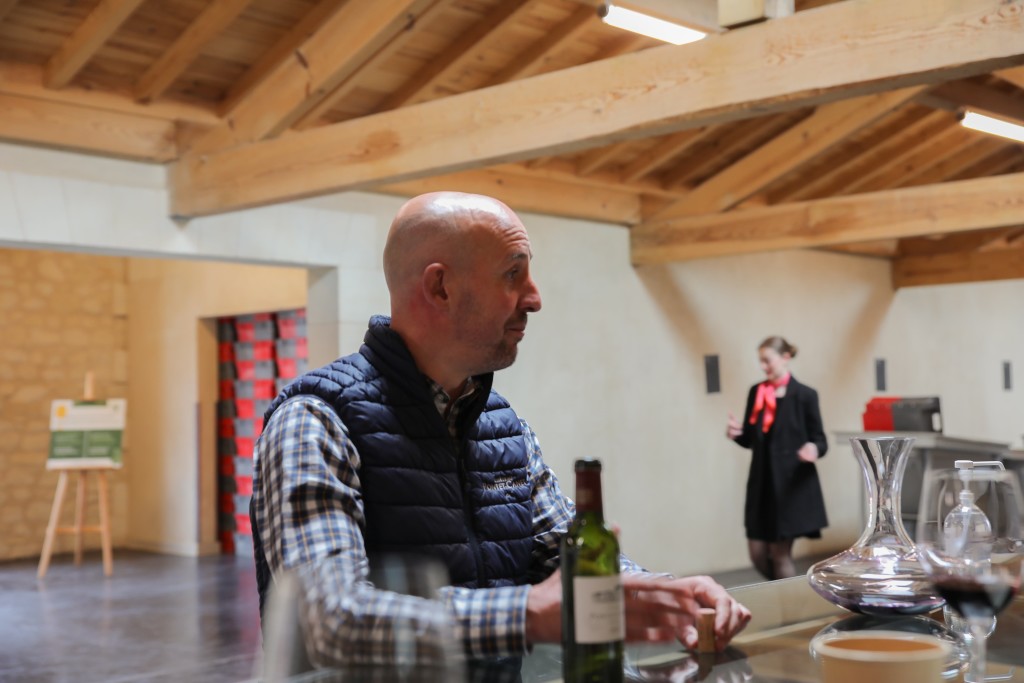
Mathieu Bessonet, Technical Director at Pontet-Canet
Pauillac
“None,” Mathieu Bessonet – Technical Director at Pontet-Canet – said firmly when I asked if he could compare 2022 to another year. Pauillac escaped the hail and almost no one reported any significant damage from the frost, however yields were still low here. As Jean-Sébastien Philippe at Ch. Lafite-Rothschild highlighted, although the tonnage of grapes wasn’t too bad, it was the volume of liquid that they released which was notable – with the berries so small and the skin-to-juice ratio so high that yields were reduced by up to a third at most estates.
Some of Lafite’s younger vines started to struggle in the heat towards the end of August and were picked early, but the fruit wasn’t deemed good enough to be used. Neighbouring First Growth Mouton Rothschild picked in earnest from 1st September, finishing on 26th September – with almost no producers still picking by October’s arrival.
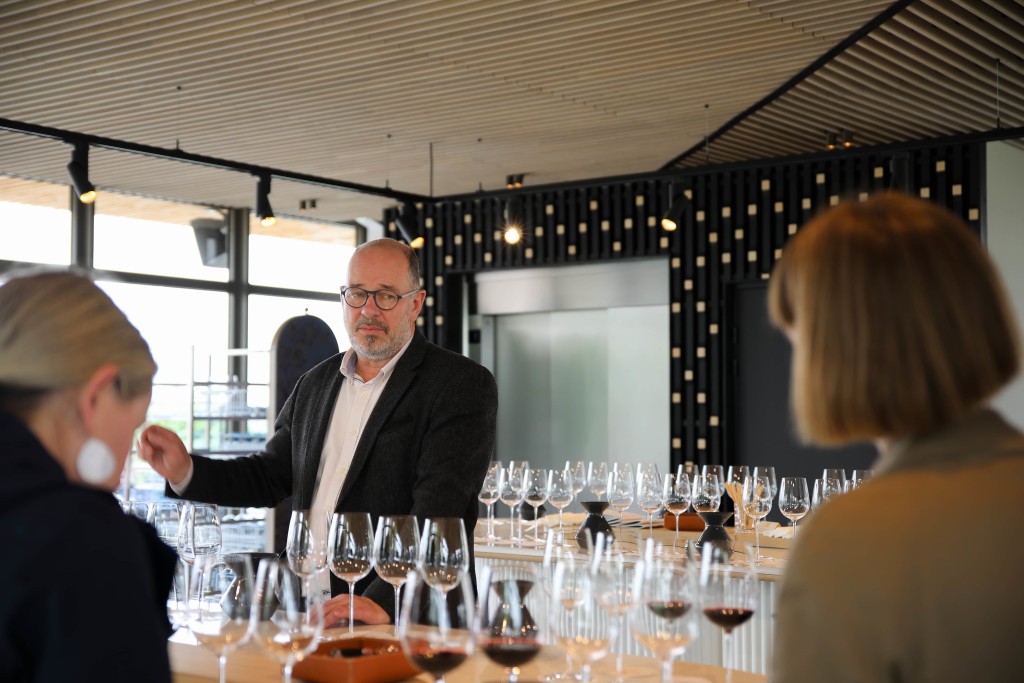
In conversation with Ch. Pichon Baron's Technical Director, Pierre Montégut
At Ch. Latour, the team recorded the lowest annual rainfall in their history – with just 615mm between October 2021 and September 2022. But there were significant storms in June, indeed the lightning in a thunderstorm on 2nd June destroyed Pontet-Canet’s office, with another following on 24th. Almost everyone we spoke to in Pauillac emphasised the higher percentage of press wine used. As vignerons tended to employ gentler extraction, the press wine was more delicate and more could be used to bring depth to the wines.
Technical Director at Ch. Pichon Baron Pierre Montégut compared the purity of Cabernet Sauvignon this year to 2019, with the richness reminding him of 2020. Bessonet feels that 2022 Pontet-Canet is more Pauillac than Pontet-Canet, but in general it seems that the extreme vintage amplified each estate’s character – as Charles Fournier at Mouton Rothschild highlighted. Taking the First Growths, Mouton is flamboyant, Lafite restrained and precise (with everything in this prestigious stable showing particularly well), Latour more stern and serious. Pauillac has produced some stunning wines at the top end this year, but there’s definitely a little more variation that needs to be considered.
This year’s Ch. Batailley – another classic expression of this stalwart estate – bears a commemorative label to the late Her Majesty Queen Elizabeth II, who served 1947 Ch. Batailley (a year with similar climatic conditions) at her Silver wedding anniversary in 1972.
Our highlights: Lafite-Rothschild, but also Carruades de Lafite-Rothschild, Pichon Comtesse, Batailley, Grand-Puy-Lacoste
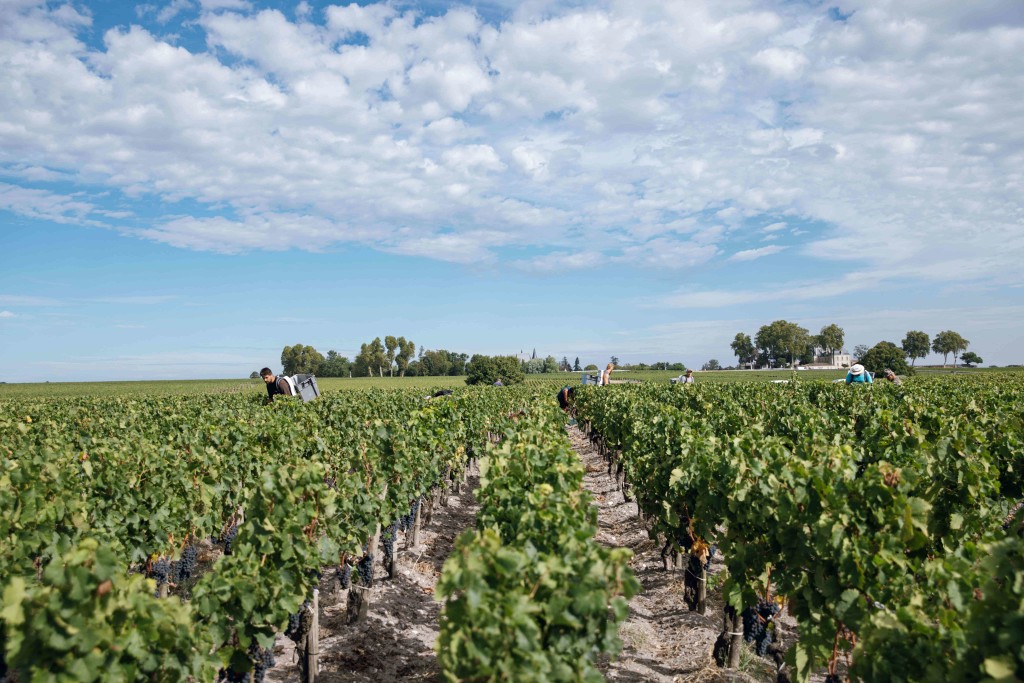
Harvest underway at Ch. Léoville Poyferré
Saint-Julien
“You’ve got to be really humble when a plant teaches you that much,” said Claire Ridley at Ch. Léoville Poyferré – referencing the vines’ resilience in the face of 2022’s extreme conditions. Despite the year’s challenges, Saint-Julien seems to have thrived, with some really impressive wines, with the Barton stable a particular standout. Damien Barton-Sartorius noted that some producers were afraid to wait for phenolic ripeness because of the rising sugar levels in the warm September conditions, but sufficiently ripe skins were key to success.
At Léoville Las Cases, the team feel the year’s climatic conditions hark back over 150 years, to 1870 – although we can’t personally vouch for the comparison, they’ve crafted a muscular, firm wine that will need serious time to reveal its full potential. (Indeed, five potential 100-point scores attest to the quality here.) Ducru-Beaucaillou highlighted the influence of oceanic mists in August, while Ridley pointed to the June storms for essential drought relief.
Harvest dates were similar to Pauillac, often starting in the second week of September and running to the end of the month. The acidity levels vary on paper from 3.6 to 3.85, yet the wines have good freshness and alcohols are generally on the more modest side for the year, with most sitting closer to 14, rather than 15. For Barton-Sartorius, the year sits happily alongside 2016 and 2019 – and possibly 1945. The appellation’s best wines are classically built, with both finesse and flesh, as well as the requisite structure for the cellar.
Our highlights: the entire Barton stable – including a stunning Mauvesin Barton (although sadly Langoa and Léoville sold out on release), Beychevelle, Léoville Las Cases, Lagrange
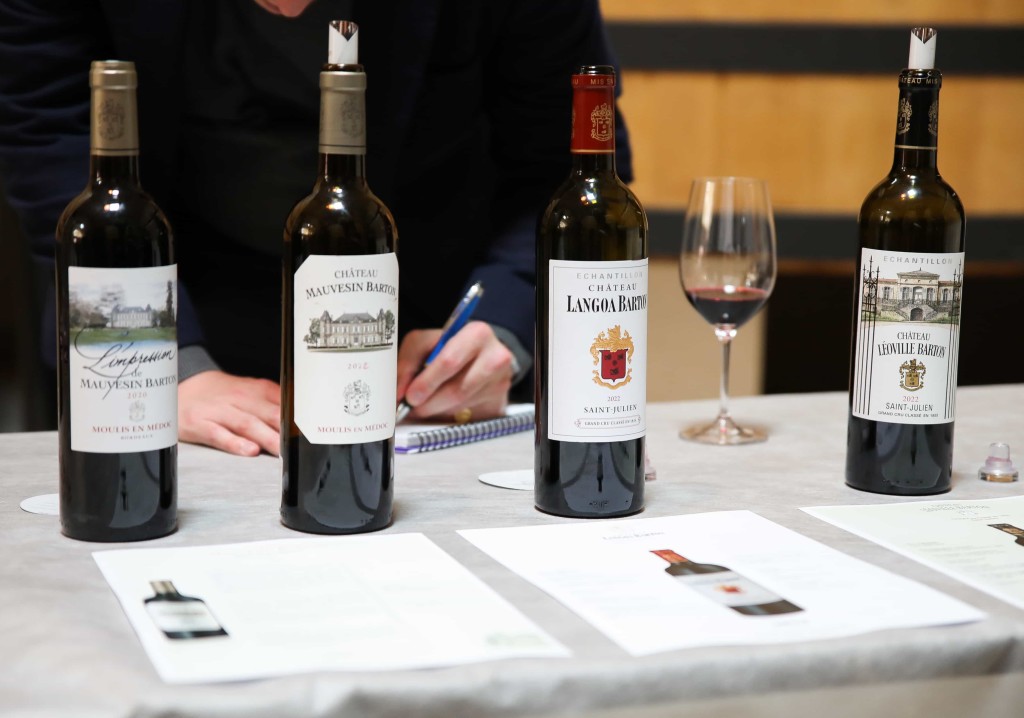
Tasting in the new winery at Ch. Langoa Barton
Margaux
“They had to find a way to survive,” Aurélien Valance at Ch. Margaux said of the vines. For him 2022 was a year that gives him hope: “2022 was very extreme – but the wines are not. For the future, it’s very promising.” They have a plot of old-vine Petit Verdot that is always used in the Grand Vin, but the wine was already so dense that it didn’t need it. The fruit from this prime site has instead been used for Pavillon Rouge, contributing to a particularly serious, firm and swarthy rendition of this second wine. Valance explained how they used the vintage as an opportunity to trial two alternatives for managing the heat: removing leaves in early June to allow the grapes to adjust to the hot sun early in the season while they had thick skins, and using kaolin – a type of clay that can be used as a sort of “sunscreen”. While they had higher yields on both these trial plots, they have bottled them separately to see how these practices impact quality over time. Their ongoing work re-orienting their vines (from north-south to east-west) will also help long term, but will take half a century or more.
At Marquis d’Alesme and Labegorce, the early April frost reduced yields, especially for the Merlot – meaning they cropped just 22hl/ha. Harvest started in the first two weeks of September, finishing by the end of the month, the earliest on record for estates like Rauzan-Ségla. Yields generally seemed lower in Margaux – dipping to around half the normal volume at several estates, often less than in 2021. At Brane-Cantenac, Henri Lurton pointed to the deep roots of the 60-year-old Cabernet planted by his late father as key to their success this year, with a thicker canopy and cool nights all contributing to the wines’ surprising freshness. While most estates opted for a lighter touch with extraction, Palmer was a notable exception – choosing instead to lean into the year’s bold structure, something that has paid off (with another five potential 100-point scores here to prove it).
As Lurton said, “It wasn’t an easy vintage to make – but in the end it’s a great one.” Indeed, he feels it’s the best wine he’s ever made. That’s certainly the case at some estates, although the appellation was definitely more variable in quality. The best wines, however, fulfil Margaux’s sensual stereotype – combining perfume with the concentration of the year, and voluptuous tannins.
Our highlights: Rauzan-Ségla, Ségla, Marquis d’Alesme, Brane-Cantenac, Pavillon Rouge du Ch. Margaux
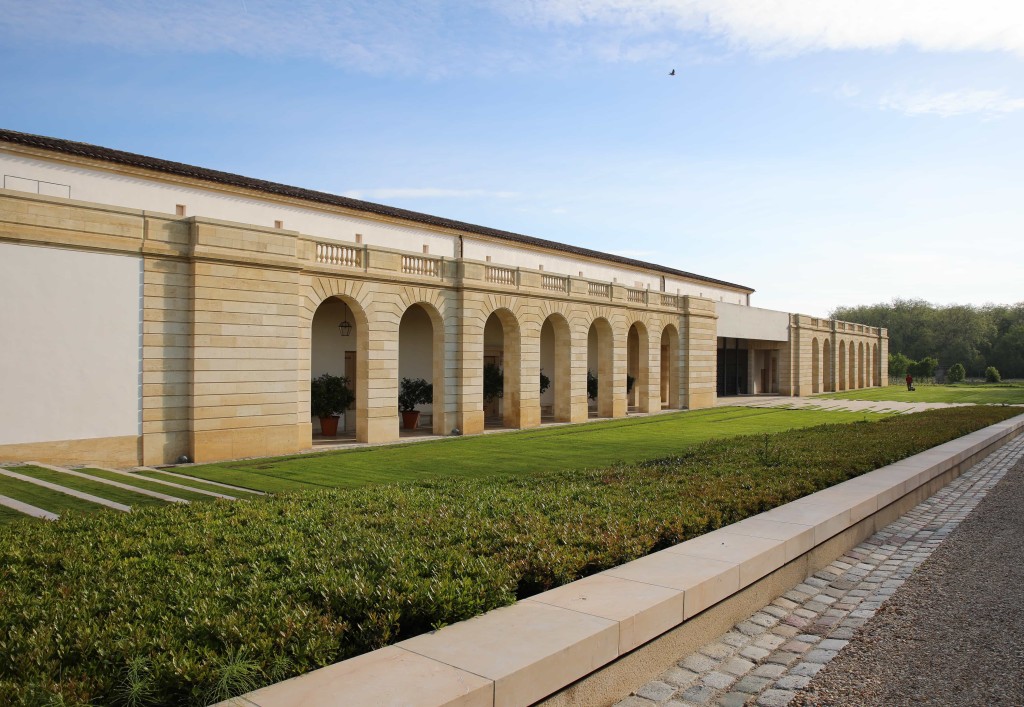
The stunning Marquis d’Alesme winery
Pessac-Léognan
For Daniel Cathiard at Ch. Smith Haut Lafitte, the vintage was “more about dryness than warmth” – indeed, having recently started working in Napa Valley (with the family’s Cathiard Vineyard), he dared to say that the conditions were “a little Californian”.
Picking in this southern commune seems most uniform, with almost everyone starting in the first week of September. Guillaume Pouthier – who has created one of the wines of the vintage at Les Carmes Haut-Brion – managed to reduce the alcohol with his use of whole-bunch and native yeast, reducing it to a modest 13.5%. Although the tannin levels are very high (with an IPT of almost 100), the wine is amazingly accessible now – with a purity and delicacy that made it tempting to steal the sample for dinner. As he said, “What is very important to me is an empty bottle.”
The style of the wines here varies, from the ultra-elegance of Carmes to a bold, ripe offering from Haut-Bailly – but, from our tastings at least, there’s good uniformity in quality, with powerful wines that are set to age well.
Our highlights: La Mission Haut-Brion, Les Carmes Haut-Brion, Domaine de Chevalier
The dry whites
Having read about the conditions of the year, you’d be forgiven thinking that the whites might be a write-off – but they’re far from it. It certainly required skill in the vineyard and winery to maintain freshness in the warm, dry year, with some that are on the more tropical side, but there are also some gorgeously taut, vibrant whites that are well worth paying attention to. The best of these are pithy, with impressive tension and an energy that reverberates through the wine. Yields at several addresses were particularly low for the whites, with frost having more of an impact on the Sauvignon Blanc, as well as the hot wind concentrating fruit further.
Although not being released en primeur, 2022 will be the first commercial vintage of a new white wine from Ch. Margaux, a junior sibling to Pavillon Blanc – one that we’re particularly excited to taste. Domaine de Chevalier Blanc is, as Adrien Bernard said, "very special this year” – and we wholeheartedly agree. While the reds often steal the limelight at Lafleur, we were particularly impressed by Champs Libres – another pure Sauvignon Blanc that sings this year.
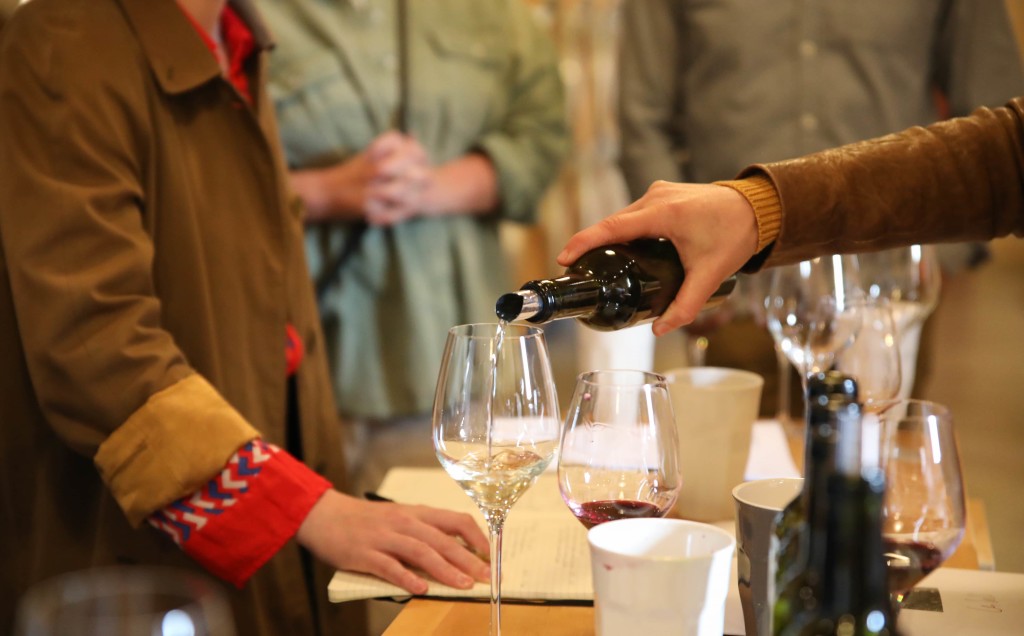
As Olivier Bernard’s (Adrien’s father’s) 40th vintage, both the Grands Vins bear a special label, with a 1941 illustration by Xu Bei Hong of a galloping horse, one that captures the energy of the year at this address. At Ch. Haut-Brion, the team was particularly impressed by the quality of the Semillon – and it ended up representing a significantly higher portion (51.4%) of the blend, and the result is impressive.
Our highlights: Pavillon Blanc du Ch. Margaux, Domaine de Chevalier Blanc, Lune d’Or, Fieuzal Blanc, Clos Floridène, Les Champs Libres, Cos d’Estournel Blanc
The sweet whites of Sauternes and Barsac
Because it was so dry, botrytis took time to develop in 2022, and it was only after the rain in early October that the noble rot took hold. A hot, dry wind over the following week resulted in rapid concentration, Pierre Montégut explained at Suduiraut, which is one reason for the purity of fruit in the wines. With this sudden concentration, the fruit needed to be picked more quickly than normal – indeed Montégut didn’t have enough pickers to bring it in as quickly as he’d have liked. The resulting wines are particularly rich and hedonistic, with notably high sugar levels at some addresses – Lafaurie-Peyraguey has a whopping 260g/l residual sugar (with 130-140g/l the number for a typical year). Yields are tiny in both Sauternes and Barsac – averaging 4hl/ha and 1.5hl/ha, respectively. Montégut explained that he would be using more new oak to help balance the richness of the fruit, which effortlessly absorbs the wood (the sample of Suduiraut we tasted was 100% new oak, but it will likely end up around 70% versus the normal 50%). He compares it to 1959, a vintage that had particularly high sugar levels for the era.
Our highlights: Suduiraut, Guiraud, Coutet
THE RIGHT BANK
There are some stunning wines from the Right Bank this year, with the wines generally more consistent (especially in Saint-Emilion), and the yields (again, mainly in Saint-Emilion) more generous versus the Left Bank.
Unusually, irrigation was permitted in both Saint-Emilion and Pomerol, however few producers have the infrastructure to water vines (beyond doing so manually) – and if they don’t have a water source themselves, it would also add significant costs. As such, few addresses that we visited took advantage of the option – and some argued that the permission to do so arrived too late in the season to be of real use.
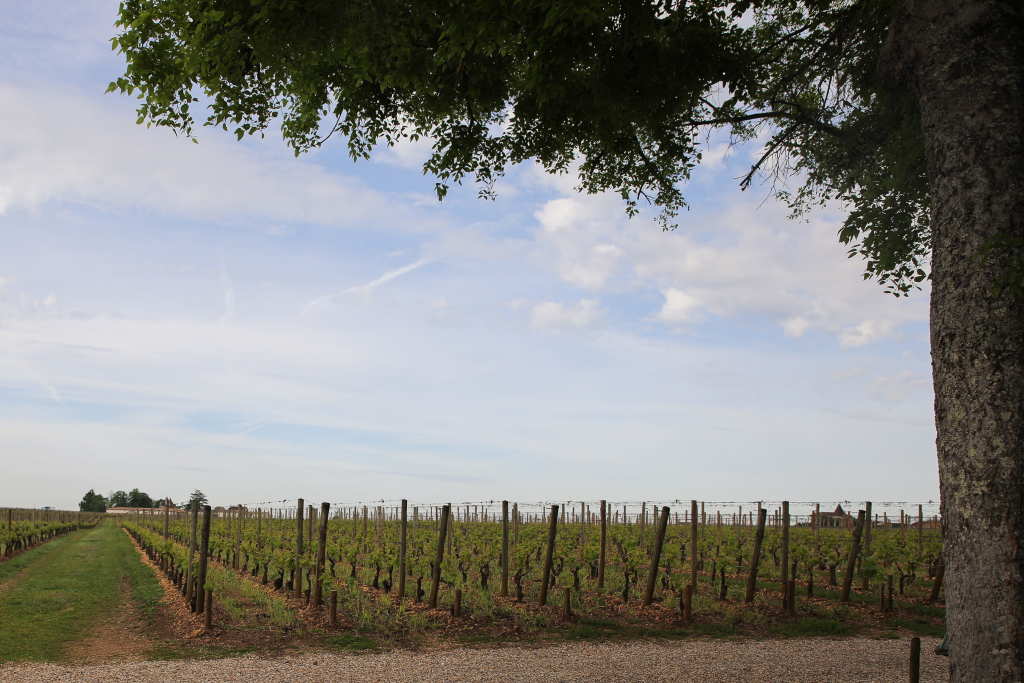
The view out across the vines at Ch. Lafleur in Pomerol
Although we only dive into the detail of Saint-Emilion and Pomerol on the Right Bank, it’s worth noting that the satellite wines from the Lafleur stable were particularly good this year, with both Les Perrières and Ch. Grand Village really impressing, and Montlandrie was a standout from the Durantous. Although we didn’t taste L’Hêtre, Jacques Thienpont (Le Pin) told us that it was “fabulous” this year – and may well be one to look out for given its pedigree.
Saint-Emilion
Saint-Emilion’s pronounced limestone soils were a godsend in 2022 – bringing incredible freshness that balances the generosity of the year beautifully, producing some of the very best wines in the vintage. Of course, the proportion of limestone in soils isn’t universal, and it’s not quite as simple as saying only those on the plateau thrived, but it certainly helped. The general trend towards restraint undoubtedly helps as well, meaning that many producers have contained and tamed the opulence of 2022, rather than exaggerating it.
It was Joséphine Duffau-Lagarrosse’s second vintage at the helm of her family estate, and she’s been working particularly hard on pruning – something she feels is the most important part of any year, looking to balance each vine rather than leave a set number of buds, which also avoids the need for a green harvest. For the Ausone stable, Edouard Vauthier feels it is a Merlot vintage, with the berries “absolutely gorgeous”. The only vines of theirs that struggled in the heat were those at Ch. de Fonbel, where they have gravel soils rather than clay/limestone.
At Ch. Canon, the team even sacrificed certain plots on particularly thin, rocky soils totally – not vinifying the fruit as the vines didn’t have sufficient water reserves to handle the dry conditions. The team at Figeac highlighted how their rootstock (Gravesac) was particularly useful this year. The seeds were already brown in August – showing just how advanced the phenolic development was.
While most estates on the Left Bank and Pomerol sit at 3.6 to 3.9pH, here some wines were as low as 3.3 (bear in mind that whites will often be around 3.2), and most sit under 3.6. There’s a noticeable exception with Cheval Blanc, however the wine has an incredible sense of freshness despite its 3.86pH, and is clearly one of the highlights of the year. As with elsewhere, old vines and deep roots were also a support – and this was particularly true at Clos de Sarpe, Laroque and Angélus. The best wines here offer enticing perfume with aromatic finesse, backed up by concentrated yet crunchy fruit, seamless tannins and mouth-watering acidity, often with a saline finish. They are spellbinding.
Our highlights: Laroque, Carillon d’Angélus, Berliquet, Beauséjour Duffau Lagarrosse, Clos de Sarpe, Cheval Blanc, Bellefont-Belcier
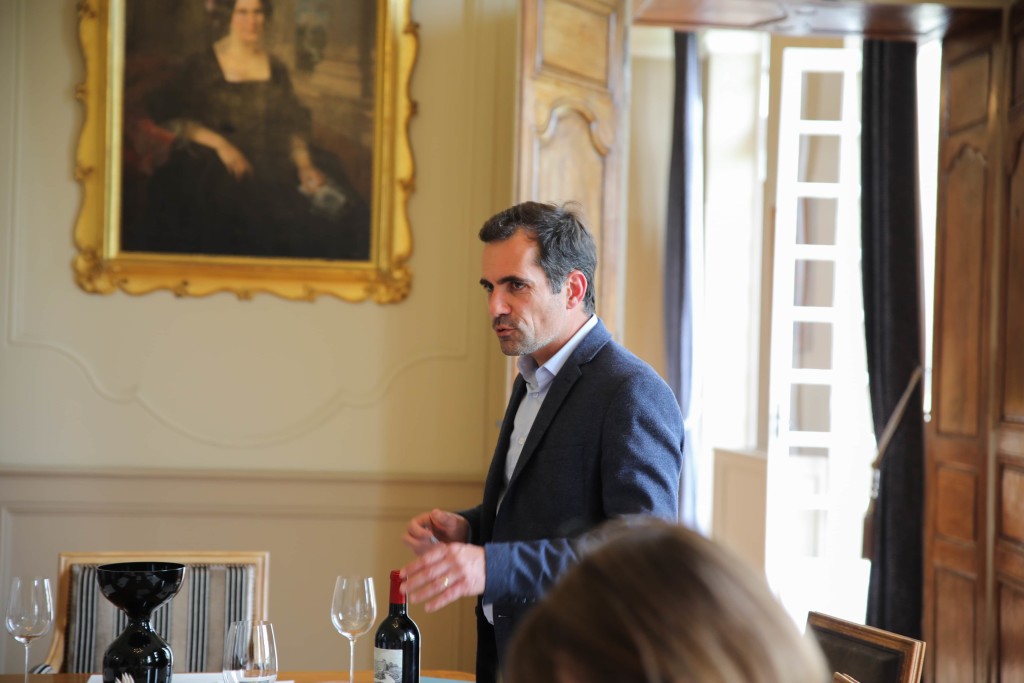
David Suire in mid-flow at Ch. Laroque, where he continues to drive quality up
Pomerol
Those fortunate to have some of this appellation’s deepest and most prized clay soils produced some stunning wines, but it was definitely trickier on those with more sand and/or gravel. There were proclamations from many producers that this is Merlot’s “comeback” – but Edouard Moueix disagrees, this was just an easy year to farm the variety: “Merlot thrives here, but it is fragile, and you must be more precise – it’s not as tough as Cabernet Sauvignon or Cabernet Franc.”
Diana Berrouet Garcia at Le Pin noted how hot it was early in the season, recalling it was already 30˚C over the Easter weekend, but the rain that arrived after every heatwave allowed the vines to recover before they were challenged once more. Ch. Clinet was one of the few properties to use irrigation when permitted, something that helped avoid the vines shutting down, along with the cool nights and their mature vines (between 35 and 40 years old on average). By contrast, at Evangile – where the team is in the middle of a replanting program and the vines average just 15 years old – Juliette Couderc was worried about them even in June, however the naturally smaller leaves reduced transpiration and allowed them to survive until harvest at the end of August.
Alexandre Thienpont (Vieux Château Certan) chose to leave more bunches than normal on the vines – eight or nine, rather than the normal five or six – eventually harvesting tiny berries that weighed less than 1g. Noëmie Durantou Reilhac (of Ch. l’Eglise-Clinet) explained how important it was to manage the extraction carefully to maintain freshness, extracting early while the musts were cool and taking it off the skins after just two to five days after fermentation was finished (when some producers choose to leave the wine macerating for up to 40 days).
The warm winds in September concentrated the berries, and are the reason that yields are generally lower, often around 20-30% less than in 2021 for those that harvested later in the month. The start of harvest ranges from the very end of August through to 16th September, and almost everyone finished before the 23rd September. Merlot from the vintage is undoubtedly opulent and we found the best wines were often – but not always – those where its exuberant personality was tamed with Cabernet, bringing a firmer, more linear structure.
Our highlights: Belle-Brise, Vieux Château Certan, L’Eglise Clinet, Blason d’Evangile, Bourgneuf, Clinet, La Conseillante, L’If









